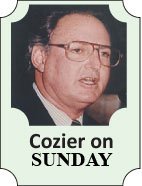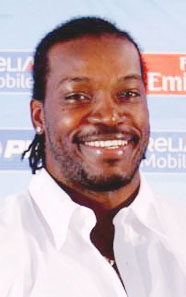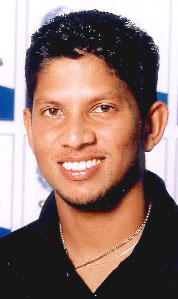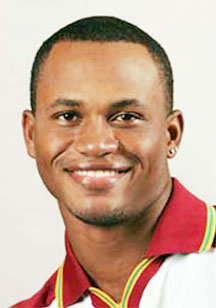While Chris Gayle, not without reason, tries to understand why he still remains basically debarred from selection, Ramnaresh Sarwan and Marlon Samuels, two other batsmen of similar vintage who have confronted different troubles of their own, have been battling to re-establish themselves in the Test team.
Both have returned this season after lay-offs for separate reasons and have had contrasting results.
 Sarwan’s place, guaranteed for so long, is now shaky, if only in the short-term. Samuels, never an assured selection, appears to have finally overcome the inconsistencies that previously blighted him.
Sarwan’s place, guaranteed for so long, is now shaky, if only in the short-term. Samuels, never an assured selection, appears to have finally overcome the inconsistencies that previously blighted him.
Both were teenaged prodigies and Test cricketers at 19. Sarwan’s first innings was an unbeaten 91 at Kensington Oval in 2000 against Pakistan bowling spearheaded by the lethal combination of Wasim Akram and Waqar Younis.
He developed into a settled and reliable No.3 in the intervening years, rising to the captaincy before the ill luck of a shoulder injury in his second match at the helm brought Gayle into the position. Behind only Gayle and Shivnarine Chanderpaul of current West Indies players in experience and record, Sarwan’s average of 41.73 in 83 Tests perhaps didn’t do his talent full justice but was respectable all the same.
Samuels’ journey since thrust into his first Test in Australia in 2000-01 after a solitary first-class match was far rockier.
It all seemed to come too easily to the laid-back Jamaican, an even more obvious natural talent than Sarwan’s. It was an approach that explained an unflattering average of 28 in 28 spasmodic Tests spread over nine years prior to this season.

Sarwan was most prolific just two years ago, at the age of 29 when batsmen are usually at their mature best. There was his 291 at Kensington along with three other hundreds, home and away, against England. The 50-plus average that Ted Dexter predicted on first watching him appeared possible.
Suddenly, his world began to fall apart.
Injuries of one kind or another kept him out of a Test in Australia and the entire 2010 home series against South Africa, prompting a stern public rebuke from team management, selectors and the WICB itself about his “extremely indifferent attitude and sporadic approach towards fitness”.
Such concerns caused him to be dropped from the tour of Sri Lanka late last year. When he returned for the World Cup in India and Bangladesh, he was clearly not himself.
Gayle, in one of his several public broadsides against Ottis Gibson, blamed the head coach for “messing” with Sarwan’s head, an unlikely take for someone of Sarwan’s experience.
In Gayle’s absence – and that of Chanderpaul for the second Test against Pakistan – Sarwan’s presence at No.3 was even more critical than usual. A shadow of himself, against Pakistani spin and Indian pace alike, his highest score in his eight innings in the Tests was 28.

Jeffrey Dujon on television commented on his static footwork. His dismissal from a flashing, edged cut and his despondency on his return to the pavilion on the final day of the second Test at Kensington yesterday revealed confidence that was clearly shot. In such a state, it would be best to stand him down for the final Test in Roseau – which does not mean, in any way, that he is finished as a Test cricketer.
Indeed, quite the opposite.
All batsmen pass through such periods – even some of the finest such as Denis Compton, Frank Worrell and Greg Chappell. He is 31 and, like those before him, his form will return. At a time when batting resources are short, a restored Sarwan is critical for the West Indies.
While Sarwan has faltered, Samuels, out of international cricket for even longer, has started to appreciate that batting at the highest level is more about substance than style.
There were hints of the talent finally blossoming in South Africa in 2007-08. His 94 and 40 were vital in the West Indies’ win in the first Test, the first in South Africa. He ended with 105 in the third and an average of 52.33.
By then, the dark shadow had formed that was to put his career on hold for two years.
It came in the form of Samuels’ conversation with an alleged illegal bookmaker, taped by the Indian police, during four ODIs in India just prior to the 2007 World Cup. Information on team selection and bowling choices were said to have been passed on and Samuels’ hotel bill on a private visit to Mumbai paid by the man.
Samuels’ part seemed more naïve than criminal but, under the International Cricket Council’s strict anti-corruption code, he was handed a two-year suspension from all cricket early in 2008.
To some, it might have signalled the end of a career that had never taken off in the first place but Samuels said all along that he would be back in West Indies colours once he was free to play again.
It could be no idle boast.
His inconsistency and lackadaisical approach did not endear him to a succession of selectors. Samuels knew only runs, and plenty of them, would put his name back in the frame.
The results came from a determination seldom before evident in his cricket. He was leading scorer in the regional T20 series and then, more significantly, in the first-class tournament. His 853 runs at an average of 65.61 were influential in Jamaica’s record retention of the championship for the fourth successive years.

Such stats couldn’t be ignored. He was back, as he said he would, for the first series of the season, against Pakistan. Even then, he had to wait for Chanderpaul’s sore shoulder and his late withdrawal on the morning of the second Test for his chance.
On a pitch that might have been constructed in Karachi, Samuels was the only West Indies batsmen to master the spin of Saeed Ajmal, Abdur Rehman and Mohammed Hefeez. The one disappointment of his top-score 57 was the way it ended, eighth out to a catch in the deep.
India followed. Once more, Samuels was kept waiting, making way for Chanderpaul’s return for the Test at Sabina Park in his native Kingston.
When he was chosen to replace Brendan Nash for the Kensington match the environment was utterly different to that encountered at Warner Park. Now he had to contend with the controlled pace and hostility of Ishant Sharma and the late each-way swing of Praveen Kumar on a lively, rain-freshened pitch.
The response was a determined, hard-fought, unbeaten 78 spanning four hours. The next highest score out of 190 was Chanderpaul’s 37.
This was the Samuels rarely seen before the shock of his suspension.
Exciting young players like Darren Bravo and Adrian Barath, are there to carry West Indies batting for the next decade. But the experience and quality of over-30s like Sarwan and Samuels must appreciate that they remain important to their development.








